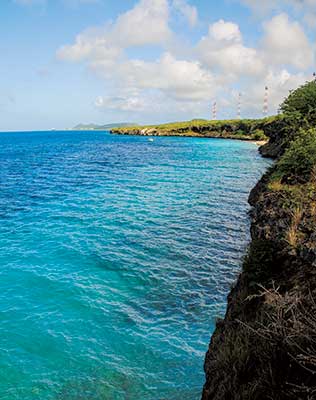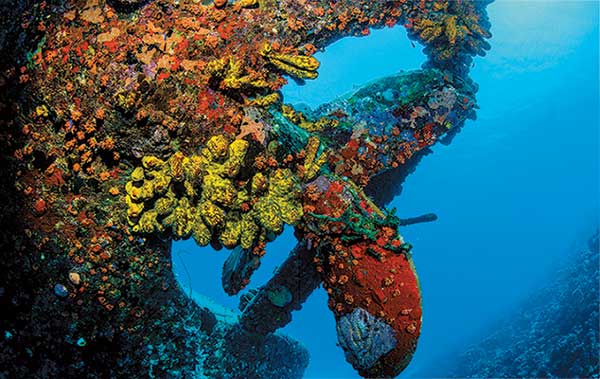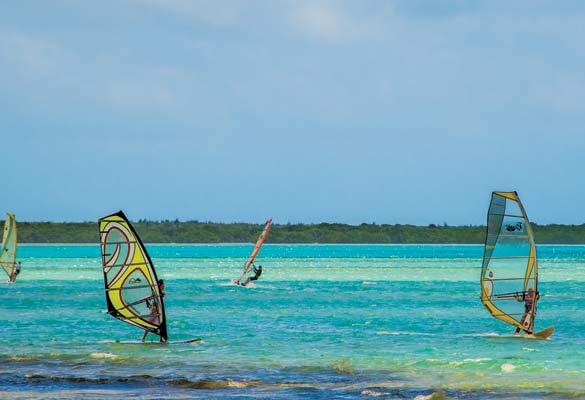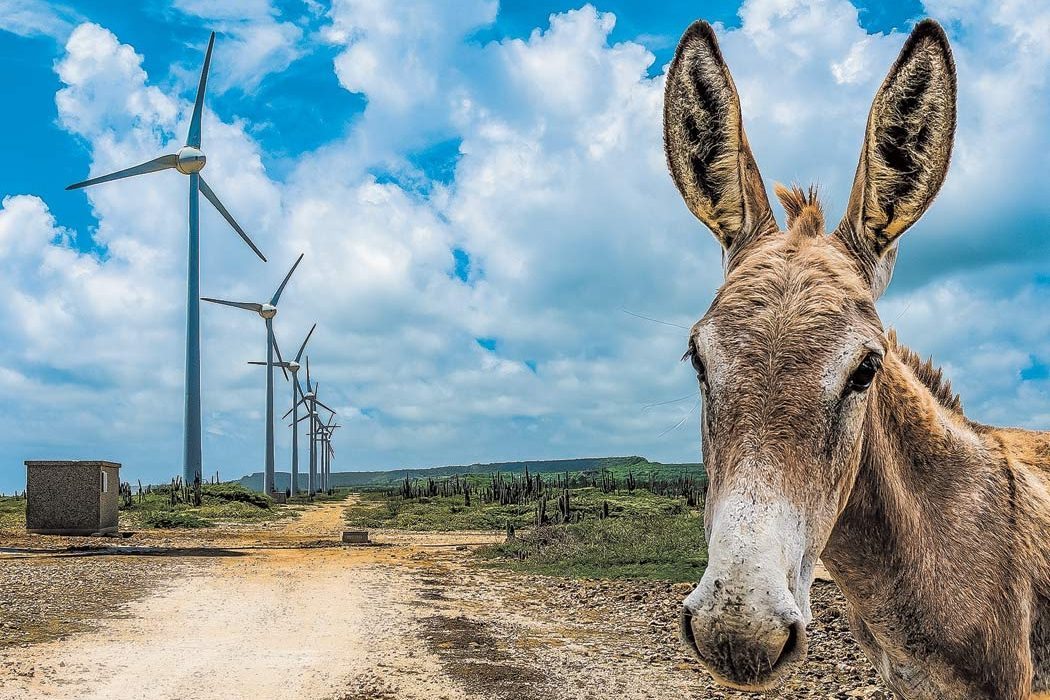The charming Dutch island of Bonaire continues to be one of the Caribbean’s top vacation destinations. Blue skies, warm sun, cooling trade winds and pristine turquoise water are just a few of the reasons why this island is so appealing. This is especially true for water enthusiasts such as scuba divers and fishermen. Although more desert than tropical, Bonaire has its own beauty filled with a variety of adventures awaiting your discovery.
Rich History
The Caiquetios, a branch of the Arawak Indians, were the earliest known inhabitants on Bonaire. They are believed to have arrived around 1300 B.C., migrating north from Venezuela to Bonaire. During an exploratory expedition in 1499, Amerigo Vespucci and Alonso de Ojeda landed on the shores of Bonaire and claimed the island for Spain. The valuable commodity of natural solar salt was one of the main attractions for the Spanish due to its importance as a food preservative. In spite of Spanish possession, the Caiquetios had the island to themselves for 3,000 years until the Dutch took possession in 1636. By the late 1600s, African slaves were imported to work on the plantations and salt pans.
From 1799 to 1816, various countries occupied Bonaire, as changing politics in Europe affected the Caribbean Islands. By 1816, the Dutch reclaimed Bonaire, along with four neighboring islands collectively known as the Netherland Antilles.
Recent history has brought significant change due to a major process of constitutional reform begun in the courts of the Netherland Antilles. The change was implemented because four of five islands making up the Netherland Antilles no longer wanted to be a part of the Netherland Antilles; however, they did want to maintain close ties. In 2005, the complexities of the constitutional reform were resolved, and in 2006 the constitutional position of the five islands was declared. The new constitutional structure of the “Kingdom of the Netherlands” was agreed upon by the Netherland Antilles and the other kingdom partners. On October 10, 2010, the Netherland Antilles ceased to exist and the charter for the kingdom of the Netherlands became official. Bonaire is now a special municipality within the country of the Netherlands.

Huge pyramids of glistening white salt crystals create a striking contrast against the blue sky.
Photo by Barry & Ruth Guimbellot.
An Arid Oasis
Our first visit to Bonaire gave us a surprise. Caribbean Islands are covered with swaying palm trees, right? Not always. Bonaire was just the opposite — covered with cactus and other hardy species of plants and animals that could survive in a semi-arid, rugged landscape where cactus grew as tall as a tree and only 22 inches (56 cm) of rain fell during an entire year. These discoveries were the first of many more exciting ones during our visit.
Bonaire is located slightly north of the equator and enjoys 12 hours of daylight year-round. Although below the hurricane belt, occasional storms have skirted over the island. Surrounding the entire island is an almost continuous fringing reef and clear turquoise water.
Local Bonaireans take pride in their homeland and are very conscious of preserving its natural resources. Their heritage reaches back many centuries to the original Indian settlers and African slaves. Locals speak as many as four languages, including Dutch, Spanish, English and Papiamentu, the native Creole language of the Dutch Caribbean Islands.
The presence of salt was a blessing and a curse in Bonaire’s history, often the root cause of struggles between European countries. Salt became the king of commodities, one of the main reasons for the Dutch takeover of Bonaire. With the abolition of slavery in 1863 and the loss of the labor force, salt production lost favor. High tariffs contributed to the dwindling interest in harvesting salt. A renewed interest in salt began in the 1960s when a U.S. company designed Solar Salt Works. Today salt production is a thriving industry on the island. Large salt pans located on the southern end of the island are a well-known tourist attraction. Huge pyramids of glistening white salt crystals create a striking picture against a blue sky.
Tourism began to blossom during the 1980s, creating more jobs than any other industry. Since the whole island is virtually a recreational playground and diver’s paradise, it is easy to understand why tourism is the reigning commodity of Bonaire.
The quaint town of Kralendijk (crawl-in-dake) serves as the capital of the island. Kaya Grandi, the main street, is lined with enticing shops and restaurants. There are also designated historical sites such as Fort Oranje scattered around town. Although the fort never saw action, old English cannons still stand guard. Today the building serves as a courthouse.
Bonaire definitely lives up to its reputation for having some of the best restaurants in the Caribbean. Everything from home cooking to fine dining is available. Extensive wine lists and creative menus are offered in the more upscale restaurants. Fresh stews, soups, fried items, and fresh fish are typical fare on the menu. Ethnic cuisine includes French, Italian and Indonesian specialties. A majority of food products are imported, with the exception of a favorite local dish — goat — used for stews and soups. Another homegrown product is maishi chiki, a type of sorghum used for pancakes and porridge. Evenings along the waterfront are especially enjoyable where dining, music and dancing are the norm.

1,000 Steps is a picture-perfect setting for a dive.
Photo by Barry & Ruth Guimbellot.
Bonaire: A Diver’s Dream
In 1962, Capt. Don Stewart arrived on Bonaire’s shores and promptly fell in love with the island. Stewart was instrumental in developing the scuba diving industry, opening Bonaire’s first dive shop. He also became a driving force behind reef preservation and the establishment of Bonaire’s National Marine Park in 1979. The park, encompassing 100 percent of the reefs around Bonaire and Klein Bonaire, became a part of the National Marine Park of the Netherland Antilles in 1999.
The leeward side offers more than 60 known dive sites, many accessible from shore. Klein Bonaire has 26 dive sites as well as spectacular snorkeling just off its pristine beaches.
Before diving, visitors must check in with a dive operator to pay a marine park fee of $25; nondivers pay $10. The fees are good for one year, and the $25 fee allows free entry into the Washington Slagbaai National Park.
Divers come from around the world to enjoy the ease and freedom of diving where they choose, when they choose, as long as they follow the rules of the marine park. The setting is perfect for avid divers, diving families and divers earning their certification. Children 10 years old can earn a junior certification, and many resorts now offer SASY — Supplied Air Snorkeling for Youth.
The majority of dive sites are on the leeward side where calm seas, shallow reefs and clear blue water give divers reasons to return again and again. Along the shore, yellow-painted rocks mark dive sites with entry points and the name of the dive area. Parking areas are available so all you have to do is grab your buddy, gear up and go diving.
[sam_ad id=”22″ codes=”true”]The wreck of the Hilma Hooker is one of Bonaire’s most popular dives. The ship rests at 100 feet (30 m) on a sandy bottom where nature has painted the wreck with a colorful variety of coral and encrusting sponges. The heavily encrusted propeller is a photographer’s dream come true. The Thousand Steps dive area is a picture-perfect setting for a dive. The name, an exaggeration, is indicative of the steps leading down to the beach, but the journey is well worth the effort. If salt freighters are not loading, you will definitely enjoy diving Salt Pier. This site is a haven for fish as well as divers.It is impossible to fully describe Bonaire’s magnificent underwater world. The best way to appreciate the marine environment is to don your scuba gear and go diving.

Over the years, nature has painted the Hilma Hooker with a colorful variety of coral and encrusting sponges.
Photo by Barry & Ruth Guimbellot.
Preservation Is Paramount
Since the early 1960s, Bonaireans have taken giant steps toward the conservation of their natural treasures. Bonaire has become an influential example in implementing environmental protection and preservation measures. STINAPA (Stichting Nationale Parken) was established in 1962 to assist in preservation efforts. The nonprofit foundation is responsible for managing the Bonaire National Marine Park and the Washington Slagbaai National. The Bonaire National Marine Park includes the entire coastline of Bonaire, Klein Bonaire and Lac. The area covers about 6,670 acres (2,668 hectares) and extends from the shore to a depth of 200 feet (61 m). Mangroves, sea grass beds and coral reefs are included in the park. The marine park is considered a demonstration site by the International Coral Reef Action Network (ICRAN) and serves as a model for marine preservation in the Caribbean. Among other duties, ICRAN maintains more than 100 public moorings, monitors safe levels of commercial and recreational use and enforces the park’s rules and regulations.

It is not unusual to see huge purple tube sponges dotted along Bonaire’s reefs.
Photo by Barry & Ruth Guimbellot.
Washington Slagbaai National Park is an amazing nature sanctuary covering 14,000 acres (5,600 hectares), including two of the island’s largest plantations from the colonial period. The park serves as a safe haven for numerous endemic and endangered species, including the yellow-shouldered parrots, parakeets, iguanas and the iconic pink flamingos often seen on Gottomere Lake. If touring the park, hire a local guide, as it is very rough country.
On Bonaire’s southern end is the Flamingo Sanctuary near the salt pans of Pekelmeer (pink lake) and the towering Willemstoren Lighthouse. There is no direct access to the sanctuary, but it is still a treat to see the handsome pink birds. The Bonaire government also protects nature’s aquatic nurseries, the mangroves, which are a vital part of the eco-system.
Widespread loss of spiny urchins and elkhorn and staghorn coral occurred throughout the Caribbean during the late 1980s. Fortunately, Ken Nedimyer of the Coral Restoration Foundation Bonaire recently developed a new technique to grow staghorn and elkhorn corals. The foundation’s goal is to “protect, conserve, restore, improve, repair and replant the reef and nature in general around Bonaire, and to set up and manage a coral plantation.” The foundation’s website says, “To date, more than 9,000 coral fragments are growing in the nurseries and over 8500 have already been transplanted.” There are four coral nurseries in waters surrounding Bonaire and Klein Bonaire.
For more info, visit crfbonaire.org.
The Queen Conch Restoration Project was established in 2010 to restore the dwindling numbers of the Queen Conch. Turtle restoration on the island is also an important part of the conservation work on Bonaire.
“Reduce, reuse, and recycle” is a strong message across Bonaire. Garbage — and what to do with it — has become a concern. Bonaireans are rising to the challenge by recycling as much as possible. Even cooking oil is recycled to make biofuel. Clean energy wind turbines are popping up across the land, and collection bins are visible everywhere. Bonaire is also dedicated to educating locals, businesses and visitors to recycle garbage and keep their island clean and green.

Surfers enjoy the thrill of skimming across the bay, mimicking the graceful flights of butterflies.
Photo by Barry & Ruth Guimbellot.
Topside Touring
Nestled in a valley north of Kralendijk is the small village of Rincon, Bonaire’s oldest town. Originally settled by the Spaniards in the 1500s, Rincon has weathered the test of time, retaining its quaint charm. The center of town consists of a small business center, a post office and one gas station where locals gather to enjoy swapping old tales and today’s news. Side streets lead visitors to historical places such as an appealing old church reminiscent of its original Spanish architecture and the Mangazina di Rei, the King’s Storehouse, used to store crops from the annual harvest. Slaves living in Rincon replenished their provisions from the Storehouse on weekends before the 12-mile (19 km) trek to the salt pans for another week of work. The building is the second-oldest stone building on Bonaire and is now a part of the Cultural Park.
We recommend a visit to the Cadushy Distillery when in Rincon. The grounds are part of an estate that date back more than a century. Bonaire’s oldest theater and the new Bonaire Heritage Foundation are also located on the grounds. The distillery is known for its famous liqueur made from the cadushy cactus.
After leaving Rincon, travel the eastern coastline for a look at the wilder side of the island. At Boka Onima fascinating inscriptions are carved into the rocks. More than 500 years old, the inscriptions are thought to be the work of the Caiquetio Indians. Near Boka Washikemba, the pounding surf has carved small cliffs in the ancient seabed, and the rugged shoreline reminds us of the ocean’s incredible power.
The Cargill salt works and Salt Pier are at the south end of Bonaire. Just past Salt Pier are slave huts in areas named White Slave and Red Slave. Towering obelisks stand in stark contrast to the tiny concrete huts that served as shelter for slaves working the salt pans. On the eastern side are Sorobon and the sheltered cove of Lac Bay, which has become famous for windsurfing due to its almost perfect conditions. Wide expanses of sand gently slope into the gorgeous aquamarine bay where trade winds constantly sweep across the shallow bay. Surfers of all levels enjoy the thrill of skimming across the bay, mimicking the graceful flights of butterflies on brightly colored gossamer wings.
Lac Bay offers more than windsurfing; it also boasts one of the Caribbean’s best-preserved mangrove forests.
Adventurers will enjoy activities including kite boarding, paddleboarding, parasailing and the popular windsurfing. Kayaking is the ideal way to enjoy the beauty of the mangroves, one of nature’s supreme ocean nurseries. Land lovers can enjoy guided or self-guided hiking, biking and nature tours — great ways to see what topside Bonaire has to offer. For the novice spelunker, there are cave tours into the underground. A visit to the Butterfly Garden and Donkey Sanctuary are especially fun for families. The Butterfly Garden has more than 20 species of butterflies from around the world. The Donkey Sanctuary is a nonprofit organization established to protect and care for the 400 feral donkeys living in the sanctuary. For equestrians, horseback riding is available. And golfers can play a round of golf on the eco-friendly 18-hole course. To relax after an adventurous day, sit back with a cool drink and enjoy a sunset cruise on Bonaire’s calm waters.
The island hosts numerous events throughout the year, celebrating Bonairean culture, food, music and activities such as sailing, windsurfing and scuba diving.
The locals are friendly people who warmly welcome visitors to their enchanting island. World-class diving still reigns supreme, but now there are many other activities to entertain visitors of all ages. With all that Bonaire has to offer, it is no surprise that the island remains one of the ultimate Caribbean destinations for fun in the sun.
Story and photos by Barry & Ruth Guimbellot.
For More Information:
Tourism Corporation Bonaire
Email: info@tourismbonaire.com
Website: tourismbonaire.com





